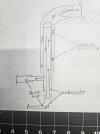Hi PJW,
In regards to your project.
I have the basement setup with a bathroom vent, I have used the steam condensing lid on the spike trio and used a lot of water. Lost count after 8 or 9 5 gallon buckets buckets of water. So to conserve water and save $.
I built out of copper fittings an insert for the steam condenser spike unit. I do not use the water spray and use 5 gallons of chilled water to circulate thru the insert.
here is a link to a video of the unit in action
20240220_154123.mp4 link expires Aug 29 2024
Currently planning to make a hood down from the ceiling fan for summer time brewing 20 inches down from ceiling small rectangle 9.375 by 10 inches and lower rectangle 20 inches by 20 inches.
PS if you plan on making a hole to install a new vent, make the hole a little bigger than the round duct so you can attach the flexible hose to the vent and push it all thru the new opening in to the ceiling space in the basement room from the outside.










